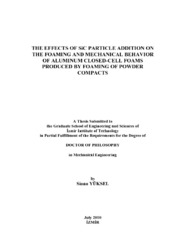Please use this identifier to cite or link to this item:
https://hdl.handle.net/11147/2979Full metadata record
| DC Field | Value | Language |
|---|---|---|
| dc.contributor.advisor | Güden, Mustafa | en |
| dc.contributor.author | Yüksel, Sinan | - |
| dc.date.accessioned | 2014-07-22T13:48:41Z | - |
| dc.date.available | 2014-07-22T13:48:41Z | - |
| dc.date.issued | 2010 | en |
| dc.identifier.uri | http://hdl.handle.net/11147/2979 | - |
| dc.description | Thesis (Doctoral)--Izmir Institute of Technology, Mechanical Engineering, Izmir, 2010 | en |
| dc.description | Includes bibliographical references (leaves: 144-153) | en |
| dc.description | Text in English; Abstract: Turkish and English | en |
| dc.description | xvi, 154 leaves | en |
| dc.description.abstract | The maximum and linear expansions of a large number of SiC particle/Al powder compacts of varying average SiC particle size (0.03-67 .m), weight percentage (wt%) and size distribution and Al compacts without particle addition were experimentally determined. The powder compacts showed varying expansion values depending on the size, wt% and size distribution of the particles. The linear and maximum expansions for small size SiC particle additions were found to be relatively high at relatively low wt%'s (5 wt%) and decreased with increasing wt% of the particles from 5 wt% to 10 and 15 wt%. The compacts with small average particle size but wider particle size distribution showed higher expansions than the compacts with the similar average particle size but narrower particle size distribution, showing the importance of the particle size distribution on the expansions of Al compacts. The foam expansions were further shown to increase with SiC particle addition until about a critical cumulative particle surface area; however, the expansions decreased significantly at increasingly high cumulative particle surface areas due to the excessive increase in the compact viscosity. For the investigated powder compacts, the optimum wt% of SiC addition was determined, as a function particle size, based on the critical cumulative particle surface area. Compression tests showed that the density of the foam was the most effective parameter in increasing the plateau stresses. Microscopic analysis showed that the main deformation mechanism in Al and SiC/Al foams was the cell wall bending, i.e. cell edges buckled over cell walls. This resembled the deformation characteristics of the open cell foams. It was finally shown that SiC particle addition increased the foam plateau stresses over those of Al foam without particle addition, which was mainly attributed to the reduced fraction of the metal on the cell edges. | en |
| dc.language.iso | en | en_US |
| dc.publisher | Izmir Institute of Technology | en |
| dc.rights | info:eu-repo/semantics/openAccess | en_US |
| dc.subject.lcsh | Foamed materials | en |
| dc.subject.lcsh | Metal foams | en |
| dc.subject.lcsh | Aluminum foam | en |
| dc.title | The effects of SiC particle addition on the foaming and mechanical behavior of aluminum closed-cell foams produced by foamming of powder compacts | en_US |
| dc.type | Doctoral Thesis | en_US |
| dc.department | Thesis (Doctoral)--İzmir Institute of Technology, Mechanical Engineering | en_US |
| dc.relation.publicationcategory | Tez | en_US |
| item.fulltext | With Fulltext | - |
| item.grantfulltext | open | - |
| item.languageiso639-1 | en | - |
| item.openairecristype | http://purl.org/coar/resource_type/c_18cf | - |
| item.cerifentitytype | Publications | - |
| item.openairetype | Doctoral Thesis | - |
| Appears in Collections: | Phd Degree / Doktora | |
Files in This Item:
| File | Description | Size | Format | |
|---|---|---|---|---|
| T000848.pdf | DoctoralThesis | 26.91 MB | Adobe PDF |  View/Open |
CORE Recommender
Page view(s)
138
checked on Nov 18, 2024
Download(s)
106
checked on Nov 18, 2024
Google ScholarTM
Check
Items in GCRIS Repository are protected by copyright, with all rights reserved, unless otherwise indicated.